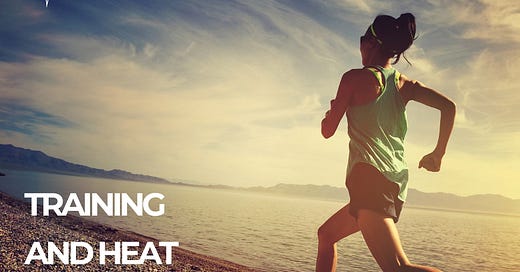The summer season is approaching, and with it the scorching days that will force you to adjust your training sessions to preserve both performance and safety.
When your body isn’t acclimated to heat, several dysfunctions occur:
Impaired thermoregulation
Core temperature (Tcore) rises rapidly.
Sweating begins late and at a low rate, limiting evaporative cooling.
Skin vasodilation is less effective, so blood flow to the skin remains insufficient to dissipate internal heat.
You become vulnerable to hyperthermia and heatstroke.
Cardiovascular drift
Stroke volume (SV) falls due to vasodilation and hypovolemia.
To compensate, heart rate (HR) increases by 15–20 % over 30–45 minutes of exercise, even at a constant workload.
Fluid and electrolyte imbalance
Inadequate sweating leads to significant fluid loss (> 2 % of body weight), increasing blood viscosity and cardiac strain.
Sodium and other electrolyte losses are not properly replaced, promoting cramps and neuromuscular issues.
Elevated metabolic demand
Involuntary thermogenesis (light shivering) and increased cardiac work raise energy expenditure, accelerating glycogen depletion.
VO₂max reduction
Linked to cardiovascular drift and lower SV, VO₂max can drop by 10–15 %, making every effort relatively more costly.
Respiratory fatigue
Hyperventilation to lose heat through the airways increases respiratory muscle fatigue.
Increased perceived effort
RPE (Rate of Perceived Exertion) climbs faster, reflecting thermal discomfort and premature fatigue.
Without heat acclimation, you are at high risk of heatstroke, syncope from hypovolemia, and neurological dysfunction.
Lars Nybo (2025) vividly demonstrates the impact of heat on performance and thermoregulation by participating in his own testing protocol. He deliberately remained non-acclimated by completing all his winter training sessions outdoors in Denmark at temperatures below 5 °C, then underwent two 50 km time trials at 40 °C in Qatar—one before and one after a two-week heat-acclimation phase. During the first trial, he maintained his usual power output for fifteen minutes, then suffered a drop of approximately 100 W over the final thirty minutes, while his core temperature reached a critical 41.1 °C; he subsequently experienced nausea for two days, clear signs of heatstroke. After two weeks of daily training in hot conditions (35–40 °C), designed to keep his core temperature above 38.5 °C, the second time trial showed a 53 W increase in average power, a three-minute improvement on the same course, a significantly lower core temperature, and no adverse post-exercise physiological responses.
This study has shown that natural-environment heat acclimation is effective and essential for optimal performance in hot conditions.
The Only Truly Effective Strategy
Training in the heat is by far the most powerful way to induce thermoregulatory adaptations. The human body is remarkably well designed, with various mechanisms to dissipate heat:
Cutaneous Vasodilation: the opening of skin blood vessels to increase cutaneous blood flow, promoting the transfer of internal heat to the surface (→ cooling via convection and radiation).
Sweat Secretion: a global evaporative process, but precisely regulated by the central nervous system to match sweat rate to ambient heat and hydration status.
Convection: the airflow over the skin removes body heat by sweeping away the thin layer of warm air at the skin surface and enhancing sweat evaporation, making convection an efficient cooling mechanism.
Respiratory Adjustments: deep, rapid breathing increases air exchange and heat loss (via water evaporation in the airways).
Blood Volume Distribution:
Increased Cardiac Output: transports more heat to the skin.
Regional Redistribution: preserves perfusion of vital organs (brain, heart) at the expense of muscles or viscera under extreme thermal stress.
Radiation: your body continuously emits infrared waves to its environment. If ambient temperature is lower than your skin temperature, this radiation transfers heat from your body to the surrounding air, contributing to your cooling.
Training in the heat enhances the various physiological mechanisms of thermoregulation. However, it is important not to begin immediately with high-intensity sessions in the heat. A progressive adaptation period of approximately two weeks is necessary to develop these essential thermoregulatory adaptations effectively (↓ HR, ↓ skin and core temperature, ↑ sweat rate).







